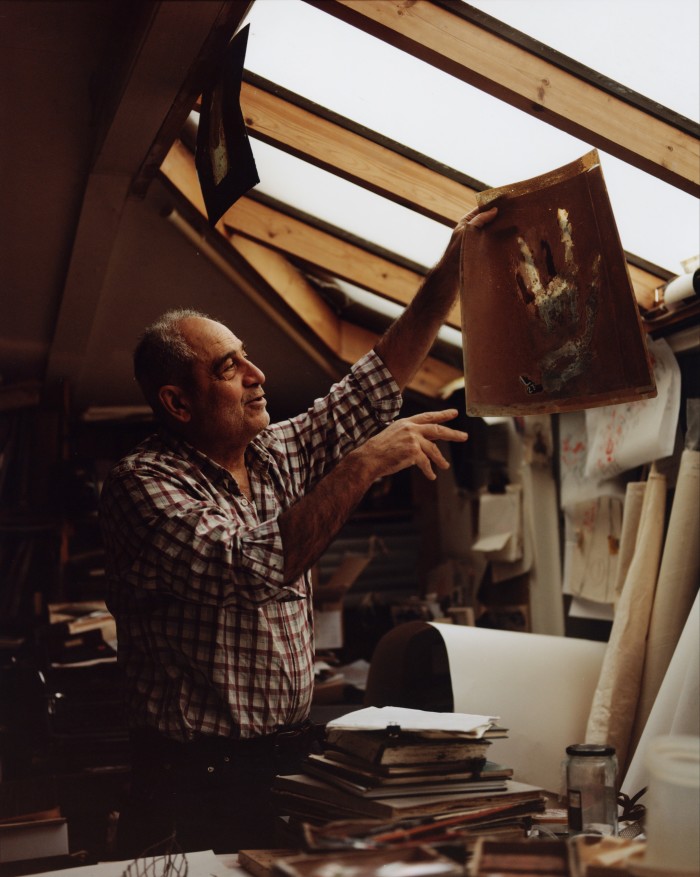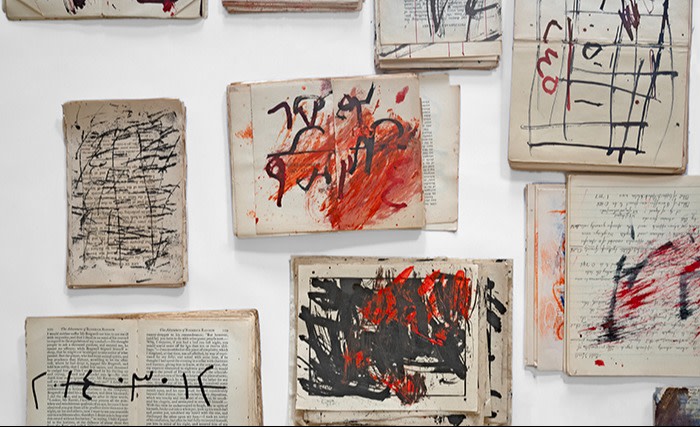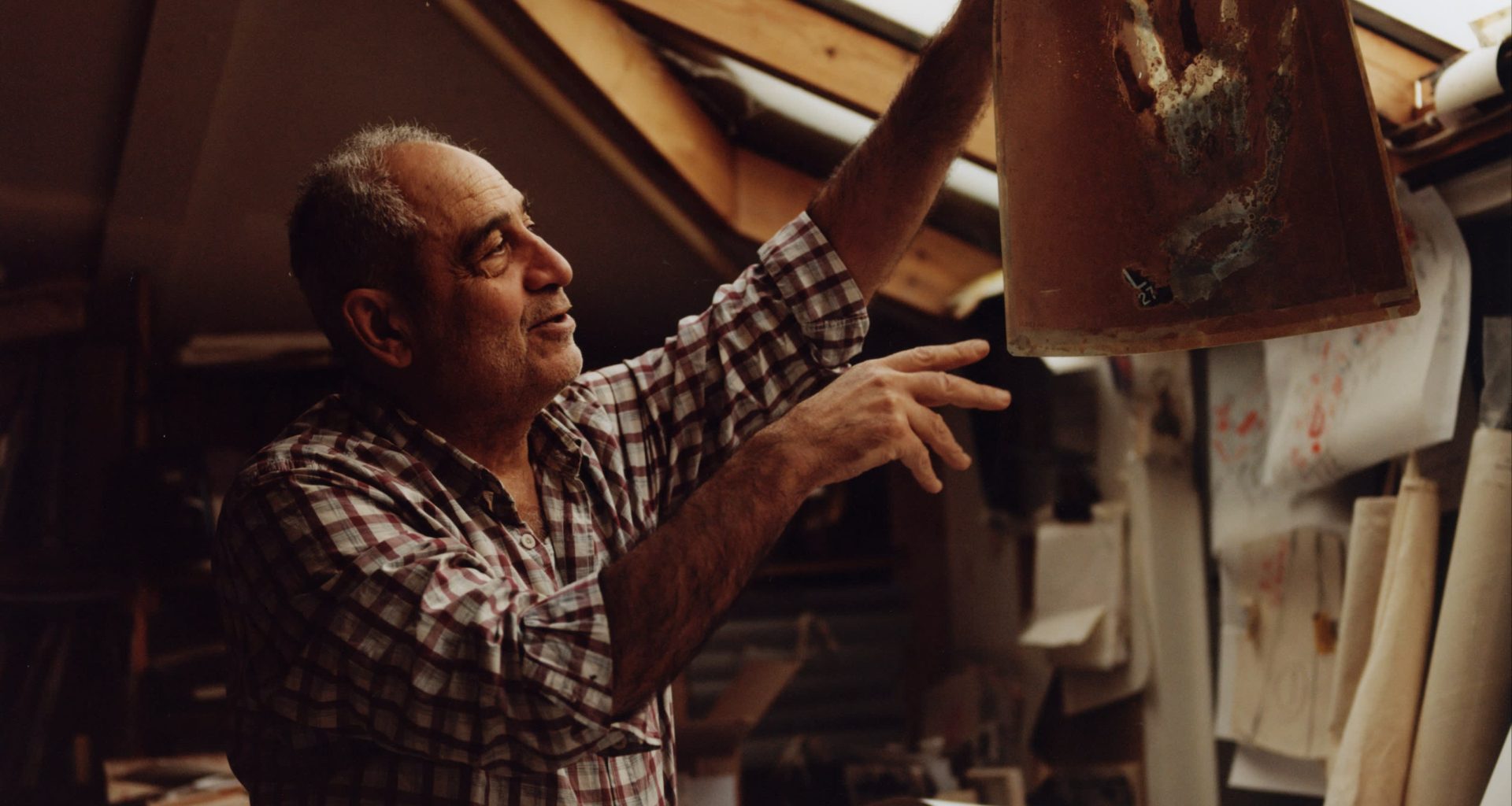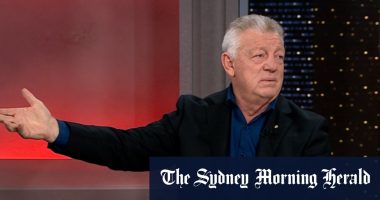Across the entire glass front of Kettle’s Yard gallery in Cambridge, Issam Kourbaj has written in Arabic, using his fingers and sometimes a brush, in blood- and flesh-coloured paint, the names of women. The letters overlap and intertwine, forming a tightly knit pattern that obscures the light. It appears as though written by a child. Later one learns that the artist had used his left hand, his non-dominant hand, and written from inside the glass and, therefore, in reverse. He intends to keep adding to it. A palimpsest for his killed and disappeared female compatriots.
Through the gate, along the path that neighbours St Peter’s Church, Kourbaj has planted Syrian wheat seeds. They have sprouted long thin grasses of a green so bright that it further darkens the rich soil of the beds. Uprooted nourishment from the war-torn country, swaying gently in the breeze as though in mourning. They are at once moving and ironic. All this is done with such unaffected naturalness that it could easily be missed. Only inside does one realise the significance of those names and the recurring theme of seeds.
Kourbaj occupies a unique place in our culture. Even before 2011, when simmering discontent with Syrian President Bashar al-Assad broke into civil war, he had been interested in the nature of destruction. In 2003, during the early days of the US-led invasion of Iraq, he produced “Sound Palimpsest”: fragments of children’s graffiti, X-ray plates, torn pages from medical files and books made up into a sort of archival lament for the destroyed libraries of Baghdad. In his well-known “Dark Water, Burning World”, from 2017, small boats made from recycled mudguards are packed with burnt matchsticks for passengers. Their scale and number alter our perception and turn these makeshift miniatures into a silent epic drama in which we are implicated. His work, held in the permanent collections of the British Museum and the Pergamon Museum in Berlin, has attempted to think about how to compose the debris.
On meeting him, which I first did several years ago, one recognises the same unaffected directness in his person. He is often dressed in plaid cotton shirts that have been made easy through use. Even after 34 years in Britain, his eyes still bring to mind a Mediterranean man well acquainted with the sun and the sea. He speaks softly and rapidly. Being with him one often gets the impression of having stepped into a gently flowing river. And like such a river, he is interested in taking you along, a man who gets no pleasure from leaving anyone behind.
Kourbaj was born in 1963 in As-Suweida, in the southernmost region of Syria, into a family that made the most of the little that they had. The first object that ever impressed him, taught him his first lesson in art, was the blanket his grandmother wove together from old pieces of torn cloth. He shows me a picture of it. He then tells me of his uncle who, to earn a living, taught himself how to defuse second world war mines buried in the surrounding landscape so as to reuse the precious metal to make spoons. Kourbaj ate his first meals with one.


He started working early, while still a schoolboy, to help his family subsist. He apprenticed as a calligraphist under his older brother Shaher. The brothers painted shop signs, words on buses and cars. He then had a grocery shop before moving to Damascus, where he did a number of odd jobs, including selling sweets at traffic lights, while studying for a degree at the Institute of Fine Arts. He graduated and returned to As-Suweida, converting the old shop into his first studio, before leaving Syria and going on to study at the Repin Institute of Fine Arts & Architecture in what was then Leningrad. Five years later, in 1990, he moved to Cambridge, the city that, with its formal facades, first struck him as “impressively cold”. It remains his home. Over the past 13 years, he has watched from a distance as the relentless conflict in his homeland has continued.
In many ways, Kourbaj has followed in the family tradition with his work, salvaging the torn and damaged, instruments of war and death, to fashion something beautiful and sustaining. He is interested in what is missed, in both senses of that word, as in what is longed for and what is being overlooked. He cannot, he admits, walk past a skip without stopping to look inside it. His imagination is enlivened by the unobliging invitation of a weathered object that is no longer wanted: old and damaged books, discarded parts of old furniture, everyday objects marked by use and yet no longer needed. In his hands, these become repositories of memory and instances for transformation and new meaning. They are, in other words, exiled objects, divorced from their original purpose and place. These are his tools and poetics.
At the centre of the exhibition — which can be read as a retrospective of his work, particularly since the war began in Syria — is the story of the imprisoned Syrian human rights lawyer Mansour Omari, who, not having anything to write with, used blood for ink to document the identities of his fellow inmates. He hid the names in his shirt seams, and this way, on his release, they left with him. This started Kourbaj’s quest for what he calls an “urgent archive” (the name of the Kettle’s Yard exhibition), which is, of course, a contradiction in terms. Archives usually lack urgency. They are meant to be patient and permanent, banks of knowledge open to different users and subject to varying interpretations. Kourbaj’s archive is all of this, yet also caught in a state of unrelenting emergency. It is a portrait of a man attempting to bear the unbearable, constantly asking himself and us how one might carry it and to what end. One of the ways that he does this is through units of measurement: a day, a month, a year, a person’s name, a seed, a matchstick.
In “Strike”, a film installation from 2018, he burns 2,559 matches, one for each day since the Syrian conflict began. What we see is a rusted metal wall, speckled in ochres, reds and blues. The artist’s bare arm emerges, having just struck a match. The flame gathers force and burns till it goes out, leaving behind a weak puff of smoke or an elegant meandering line. No two matches burn the same way, and the hand that wields them is clean but not impartial. Its fingertips refuse to let go till the wood burns all the way through.
A determined attempt to witness and to mark. But contained in it is also the commonplace bewilderment of how one ought to relate the specific to the statistical, to picture an individual life among the thousands affected. Because the flip side of striking a match for each day of the war, and doing so for seven years, is also the wish to be done with it.

Kourbaj is cognisant of this contradiction, that in the end, no matter what he does, he will fail, because such horrors are impossible to archive, let alone archive away. You cannot pull water out of the sea, as he tries to do in another video installation, “Shores of Power”, from 2019, with the use of old mattresses. And you cannot remember every name, as in the piece “Killed, Detained and Missing (Women)”, also from 2019, made up of two pianola scrolls on which he wrote the names of thousands of Syrian women who had been subjected to such fates. The work is accompanied by an audio recording of the artist reading, on and on, each name. His radio voice is clear and sober, but as lonesome and lost as a small boat mid-sea.
These manoeuvres are compounded by gestures of destruction. In the second room, we watch a film of him painting black sweeping brushstrokes on a piece of white paper pinned to a wall, only to then tear it up and eventually set fire to the pile.
One senses, walking through, that Kourbaj expects that we behave less as spectators and more like participants. That the work is not there merely for our entertainment, but offers us tools to make use of in our own lives. That, what with its larger themes of remembrance and grief, this archive can only be completed by our involvement.



Walking through the exhibition, I ask him whether Urgent Archive is an attempt to forget or to remember? “I would say I am doing both,” he says. “It is my way of speaking to my family in Syria, of saying I am here thinking of you. It is also a message of guilt, because to be away, in a place where birds still sing and you have electricity, running water and connection to the internet, you feel guilty. How many times I wanted to speak to my sisters, to ask them about their lives. I long to hear them. But it is impossible. How do you do it?”
The question hovers a little before he continues.
“In the end, this is all I can do. Art becomes my means of survival.” Then, without as much as a pause, he shifts gears and begins speaking about the one person he misses the most, his wife and the mother of his two sons, the Argentine-Spanish artist Candelaria Capurro Ferrer, who passed away in 2022. He nursed her while working on the Urgent Archive exhibition. He consulted her about every detail, and she was part of every decision. “To have your own love just in front of your eyes being erased, that is something that I never thought I could survive. I felt this will either finish me or will make me a better person. I chose not to bury it, but to carry it.”


I thought of the Arabic word for human being, insaan, and how it is derived from the word nisyaan, meaning forgetfulness. Each language has its philosophy. According to the Arabic, being human is also being forgetful. And yet here is this good and forgetful man determined to remember, kind and generous, a loving husband and father. These may seem extra-artistic virtues, but not when it comes to his work, which is as much about the intention of truly being human as it is a heroic act against oblivion.
“Urgency,” he suddenly says, “has in it the word urge. The urge to give birth, to grow. Seeds have that urge. And in a place where you are confined [such as a prison], there is someone there who is still thinking of the urge to record the names of the prisoners, at least so as to later inform their families that they exist, that they are alive.”


This ability to retain a nourishing knowledge, to preserve and then offer it, is part of his interest in seeds. A seed is its own archive, as it contains past evidence, present promise and future yield.
A tent is hung on the wall like a sail. Across it, as though lines of text, Kourbaj has woven hundreds of date seeds into the fabric. They bend and twist across the canvas and in places look like gnawing teeth. Then a scroll of thermal paper, on which he has written using the flame of a match. A fire brush that lasts only as long as the flame burns. The rich and haunting dark brown shapes it paints are nearly legible.
Ultimately, Kourbaj is a painter, although rarely on an empty canvas; he often paints over things. His command of line, colour and form is breathtaking. The central piece in the exhibition, titled “Urgent Archives, Written in Blood” (2019), is made of about 100 volumes of various sorts — second-hand books, sheet music, used notebooks and ledgers — and stamped and addressed envelopes. All are laid out in the shape of a large carpet on the floor. The artist has drawn or painted on every piece of paper and every spread of each book. From time to time, he wanders in to turn the pages, as the gallery visitors come and go. The entire display is then altered. It makes one constantly conscious of the other unseen pages in the dark. This piece alone contains somewhere between 8,000 to 10,000 small paintings.

This way of proceeding, of creating an assemblage of moving parts that is at once mobile and unpredictable, free and, in the best possible sense, anarchistic, creates a seemingly infinite archive that is as pressing as it is generative. Here Kourbaj, an artist fashioned by fate and history, speaks with unerring directness. And suddenly you realise that what you are looking at is not about Syria or one man’s private trauma, but an urging instance where our world — with all of its anguish and instability, all of its tenderness and pain — is held and reflected through this remembering man, an artist of a rare and deeply humane sensibility.
We leave the gallery, and he invites me to his house. While we have been at Kettle’s Yard, his brother Shaher, who is visiting from his home in the US, has been cooking us lunch. After we eat, Issam walks me down the path that leads to his studio. He leaves me there and runs back to fetch tea. I sit under the pitched roof, with its windows aimed at the sky. The room is packed with work, paint and salvaged objects. I remember what he told me just before he left, about how even in her final days, when she was terribly unwell, his wife would walk here to be with him and watch him work.
“Issam Kourbaj: Urgent Archive” is at Kettle’s Yard until May 26. Hisham Matar’s latest novel, “My Friends”, is published by Viking
Follow @FTMag to find out about our latest stories first and subscribe to our podcast Life and Art wherever you listen
Read More: World News | Entertainment News | Celeb News
FT









